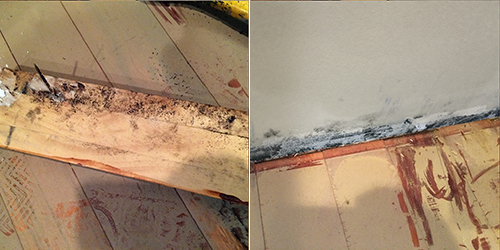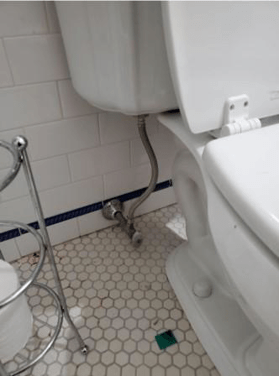They are making several great pointers relating to How to Fix a Water Damage Bathroom in general in the content which follows.

The restroom is exceptionally prone for moist buildup and possible water damages due to the constant use of water in it. This write-up supplies basic inspection methods to help identifying water damage hazards.
The regular use of water in the shower room makes it extremely prone for wet accumulation and prospective water damages. By inspecting it on a regular basis, you can lower water related problems.
The following set of inspections is very easy to perform and must be done as soon as in every three months in order to maintain your bathroom in good shape and also to prevent possible water damages triggered by the bath tub, the shower, pipe joints and also plumbing, sinks, cabinets, as well as the commode
Do not forget performing these assessments and also be comprehensive while doing them. Remember that these easy assessments can conserve you a lot of cash by giving early indicators for water damages
Bathtub and Shower
The shower as well as bath tub require special focus and also maintenance. Inspect the floor tiles and replace if split. Make certain that there is no missing out on cement in between the tiles. Examine as well as change cracked caulking at joints where the walls satisfy the flooring or the bath tub. Clogged drains as well as pipes issues will certainly protect against the bathtub from drying as well as might show serious problems below the tub. Talk to a specialist promptly to stop structural damage. Take note of discolorations or soft areas around the tub walls as they might show an interior leak.
Plumbing
Signs for water damages are difficult to find since many pipes are set up inside the walls.
Pay special interest to floor covering as well as wall surfaces wetness as well as spots as they may suggest an invisible plumbing problem. Check moisture levels in adjoining areas too.
Sinks and also Cabinets
Sinks and also closets are revealed to dampness and also moisture everyday and also are often overlooked. Evaluate consistently under the sink and also on the kitchen counter over it. Repair any type of drip in the trap as it may recommend drainpipe troubles. Browse the sink, slow draining pipes may show an obstructed drainpipe. Replace sink seals if they are broken or loose.
The Commode
The commode is a prone water junction. Check the water lines and look for leaks around the commode seat, in the tube, as well as under the water storage tank. If you spot any indicators of dampness on the floor around the toilet, look for leakages in the toilet rim and storage tank seals.
Understand that hanging toilet dish antiperspirants enhances the chances for obstructions.
How to Prevent Water Damage in Your Bathroom?
Water damage repair is an expensive, meticulous, and lengthy process. Unfortunately, bathrooms are the most susceptible rooms to water damage due to toilets, showers, and sinks. Pipes and fixtures wear out over time and are not immune to damage. But all is not lost, as there are ways to prevent water damage from occurring in your bathroom.
Check Your Plumbing
Nothing lasts forever, especially pipes, which can rust and begin leaking over time. You should periodically conduct pipe inspections and pay attention for any musty smells or water stains that may indicate you need water damage repair. Here are some things to check:
Frequently test valves for your toilet, shower, and sink to ensure they are properly working. Check faucet supply lines hidden under vanities and replace when needed. Replace cracked or deteriorating caulking along sinks, tubs, and showers. If you notice a clog in your sink, call in a professional. Since you can’t check the pipes in the wall, keep an eye out for stains, drywall bubbling, musty smells, and excess moisture; if the bathroom is on a second level, check the ceiling of the room directly below for these signs. Don’t Overwork Your Toilet
One of the most common reasons bathrooms need water damage repair is due to overflowing toilets. Save yourself the hassle of cleanup by being mindful and not pushing your toilet to extreme limits. If you have young children, it is especially important to keep an eye on them when they are in the bathroom and to teach them how to avoid clogging the toilet. Here are some more tips to help prevent your toilet from overflowing:
If you have a septic tank, only use septic-safe toilet paper Do not flush anything down the toilet besides toilet paper; items like diapers and sanitary napkins will clog the piping Pay attention to your toilet’s water level: If it’s low, it could mean it is partially clogged or that there is a crack in the toilet bowl Maintain Your Shower/Tub
Replace showers or tubs with cracks or other damage; even hairline cracks can allow water to seep in and cause damage. Grout and caulk help prevent water from seeping into walls and floors, so repair them if they are chipped, cracked, or deteriorating. Replace torn shower curtains or shower doors with seals that no longer work. Dry the floor and drain water from the tub immediately after use to prevent damage from sitting water. https://www.alure.com/home-improvements-blog/resources/how-to-prevent-water-damage-in-your-bathroom

We had been shown that editorial on Preventing Water Damage in the Bathroom through an acquaintance on another domain. You should take the opportunity to distribute this article if you enjoyed it. Kudos for your time. Visit us again soon.
Customer Reviews